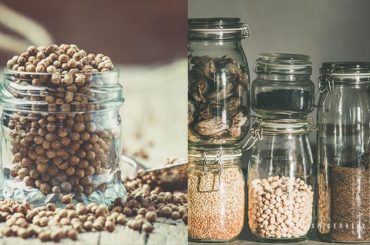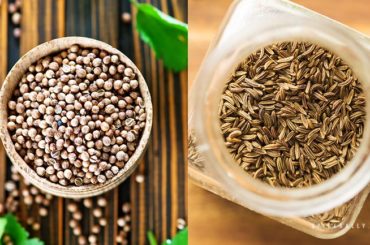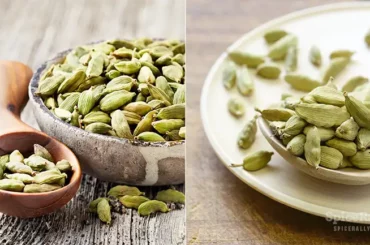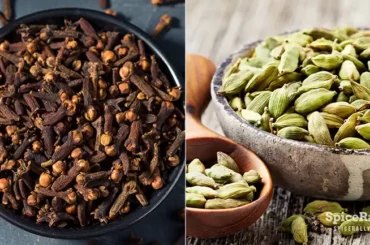Vanilla ice cream, vanilla cake, vanilla cookies…we bet you wouldn’t literally find any sweet or dessert without a touch of this wonderful spice. So, this article unveils everything you need to know about vanilla.
Vanilla is a popular baking spice around the world that derives from the bean of a climbing orchid. It is the second most expensive spice in the world that offers an unparalleled aroma and rich flavor. Vanilla is mostly used in baking, confectionery, beverages, modern pharmacology, perfumery, cosmetology, etc.
So, let us take you on a sweet little escapade that will enlighten you with the incredible flavor and aroma story of our ultimate baking staple- vanilla!
What Is Vanilla?
Whenever you bake cookies or, let’s say, a cake, your entire house tends to fill with an amazing aroma, and without bounding into that space, this smell also goes to other neighborhoods!
Vanilla (genus Vanilla planifolia) is any member of a bunch of tropical climbing orchids (family Orchidaceae) native to Central and South America and the Caribbean. It is mainly used as a flavoring agent in baking and cooking, extracted from their pods.
Mostly Used Types Of Vanilla
The vanilla beans are basically the cured unripe fruit of the vanilla plant. There are more than 100 species of vanilla in the world. But, four types are prominently grown and used. They are:
- Madagascar or Bourbon vanilla – These vanilla beans are considered the best and the most used variety in the world. They have a profound, strong, creamy flavor.
- Mexican Vanilla Beans – Mexican vanilla beans are believed to be some of the best beans in the world. And they have a delicate, smoky vanilla flavor with a touch of spice.
- Tahitian Vanilla Beans – Tahitian vanilla beans possess a distinctive floral flavor with hints of cherry and licorice. Among the most pricey types of vanilla, these vanilla beans are almost twice the size of other vanilla beans.
- Ugandan Vanilla Beans – These vanilla beans are not as well known as the rest in our list, but they have high amounts of natural vanillin, which gives them a bold, intense flavor and fragrance.
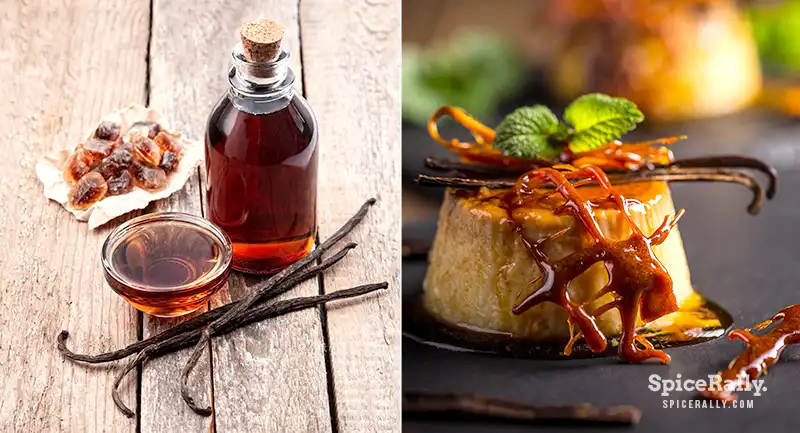
Countries That Produce Vanilla
The largest vanilla producer in the world is Madagascar, and the second largest is considered to be Indonesia.
Other top vanilla-producing countries include:
- Mexico
- China
- Asia
- Africa
- Papua New Guinea
- Turkey
- Uganda
- Tonga
- French Polynesia
- Reunion
- Malawi
A Quick Glance At The Origin And History Of Vanilla…
The first humans to have grown vanilla were the Totonacs of Mexico’s east coast. The Aztecs acquired this spice when they overpowered the Totonacs in the 15th century. The data sources assert that it was introduced to western Europe by Hernán Cortés.
The Aztecs were believed to have drunk their “chocolatl” with a dash of vanilla. And this ingredient was thought of as nothing more than a complement for chocolate until the early 17th century, when Hugh Morgan, an ingenious apothecary who worked for Queen Elizabeth I, created chocolate-free, all-vanilla-flavored sweetmeats.
By the 18th century, the French were employing vanilla to flavor ice cream- the delightful treat discovered by Thomas Jefferson in the 1780s. And according to food historian Waverley Root, the first available vanilla recipe arises in the 1805 edition of Hannah Glasse’s “The Art of Cookery.”
Processing Of Vanilla Beans
At first, fresh vanilla fruits, which are known as “beans,” have no fragrance. In fact, the distinctive aroma of vanilla results from enzymatic activity during curing.
The conventional method starts when the harvested beans are subjected to a process of nightly sweating and customary exposure to the sun for about ten days. After about ten days, they get a rich chocolate-brown color.
Then the vanilla beans are scattered on trays in a well-ventilated shelter until arid enough for grading and packing. The curing and drying process generally demands four to five months.
The best grade of cured seed pods is usually covered with microscopic vanillin crystals, providing a deep, unique, sweet aroma. And vanillin is the primary chemical compound of the extract of the vanilla bean.
What Do Vanilla Taste And Smell Like?
Undoubtedly, vanilla is one of the most fragrant in our pantry. As mentioned previously, it gets its distinctively sweet, fruity, magical aroma from its natural compound, vanillin.
The core taste of vanilla can be described as creamy, floral, and fruity with earthy, nutty, and sometimes rum-like undertones.
Is Vanilla Really A Spice?
Commonly recognized as a flavoring agent, botanically, vanilla belongs to the category of spices. In fact, this is one of the most complex and subtle spices on earth!
How To Use Vanilla?
As we all know, the primary usage of vanilla is in baking. In addition, it is also widely used in commercial confectionaries, dairy products, beverages, and some savory applications.
However, the versatility of this spice reaches far beyond culinary uses and extends to skin and hair care products, perfumery, cosmetology, household uses, and many more!
Forms Of Vanilla And How They Are Used In Cooking/Baking
Vanilla can come to your pantry in several forms, and each form could be used to flavor and aromatize different types of dishes.
01- Vanilla Beans
Vanilla beans are the most expensive form of natural vanilla flavor. They are small, dark brown, pulpy seeds that hold a highly concentrated, strong, and complex vanilla flavor.
Using real vanilla beans could elevate your dishes to a whole new level and it also adds a touch of color from the seeds along with flavor and fragrance. These beans can be used as follows:
- In uncooked or slightly simmered recipes
- Artisan quality desserts
- Ice cream
- Smoothies
- Buttercreams
02- Pure Vanilla Extract
This is produced by saturating ground vanilla beans in a solution of water and alcohol. It must contain 13.35% vanilla bean solids and 35% alcohol for the product to be labeled “pure.”
Some vanilla extract options contain corn syrup or sugar to improve the flavor of low-quality vanilla beans. But it is always better to go for a pure vanilla extract that includes only vanilla bean, water, and alcohol that will become more flavorful with time.
It is a thin, brown liquid with a delicate, mellow vanilla flavor. Pure vanilla extract is way cheaper than vanilla beans; therefore, it is highly efficient in commercial and high-volume bakeries, confectionery, etc. Try this form in your:
- Cookies and biscuits
- Bread and brownies
- Cakes and muffins
- Smoothies
- Syrups
- Frostings
- Sauces
- Puddings, ice creams, and yogurt
03- Vanilla Bean Paste
Vanilla bean paste is basically a thick, jelly-like paste with specks of brown seeds and a deep, smooth vanilla flavor. It is made from the scraped seeds of a vanilla bean put up in a dense extract.
The vanilla paste contains the most concentrated flavor next to the real vanilla bean. The actual usefulness of vanilla bean paste is that it delivers a robust flavor and has natural seeds but doesn’t need the same practice as the bean.
In fact, it is cheaper than vanilla beans and more concentrated than vanilla extract, making it a satisfying medium between the two.
Moreover, vanilla bean paste also contains less liquid than vanilla extracts, so it won’t make your recipes too moist. Use this in:
- Ice creams, puddings, and custards
- Light-colored cakes
- Frosting
04- Artificial Vanilla Extract (Vanilla Essence)
Artificial or imitation vanilla extract is a thin, less concentrated, brown, or clear liquid with a slightly bitter, potent one-note vanilla flavor. This is made from artificial vanillin.
It lacks the intricate, nuanced flavors of natural vanilla since artificial vanilla only includes one flavor compound. But still, imitation vanilla does have some uses in the kitchen.
Vanilla beans, extract, and paste has more profundity of flavor than artificial vanilla, but many of those flavor notes defile at the high temperatures used during baking.
For this reason, synthetic vanilla is favored by some bakers for cakes and cookies. In addition, vanilla essence can be used in the making:
- Drinks
- Puddings, yogurt, and ice cream
- Biscuits, bread, and buns
My secret indulgent food is dessert. I have an incredible sweet tooth – chocolate pudding with vanilla ice cream or trifle and pavlova. I do love dessert.
Deborra-Lee Furness
05- Vanilla Powder
Vanilla powder is a versatile, dry brown powder with a rich, complex flavor produced from dried, ground vanilla beans. And the pure form of vanilla powder includes no fillers and should have a light brown to dark brown color.
If the vanilla powder is white, it might contain sugar or maltodextrin and has different uses. It is always best to look for pure vanilla powder in order to have a decadent, concentrated vanilla flavor.
However, it can be as expensive as vanilla beans. And since vanilla powder contains no liquids, it can be incorporated into buttercreams or batters without watering down the texture. It also has a potent flavor so that it doesn’t impair or burn off at high temperatures. Accordingly, you can try vanilla powder with the following:
- Desserts that require a balanced ratio of liquid and dry ingredients
- Dry mixes
- Buttercreams
06- Vanilla Syrup
Vanilla syrup is a thick, syrup-like liquid with a sugary, sweet vanilla flavor, and it is made from sugar, water, and vanilla extract.
You can effectively use vanilla flavoring syrup to sweeten beverages and desserts and add a tinge of vanilla flavor.
Most vanilla syrups are packaged in large bottles with a pump dispenser, making it more comfortable to add syrup to cocktails and coffee drinks. But, this is not suitable for baking applications. However, you can also try vanilla syrup with:
- Flavored sodas
- Egg creams
- Signature shakes
- Smoothies and tea
- To make other syrups
07- Vanilla Sugar
Vanilla sugar is more like a by-product of vanilla which is made by infusing natural vanilla beans or vanilla extract with regular sugar. It is a dry, sweet-tasting mixture with a concentrated vanilla flavor.
Vanilla sugar is comparatively lower in price than vanilla beans. And it is used in baking and in pinches to savory preparations like barbecue sauces and vinaigrettes to give a contrasting taste. You could also use this vanilla form with the following:
- Coffee, tea, shakes, and smoothies
- Light desserts
- Confectionary
General Uses Of Vanilla
In addition to vanilla’s primary usage in cooking or baking, this spice is also helpful in several other household practices. For example, Vanilla Essential Oil is used in:
- Bath, hair, and body oils
- To remove bad breath
- For dental care
- In body scrubs
- Bath salts
- As a natural air freshener
- To make scented candles
- To be placed in humidifiers and oil diffusers
Moreover, the vanilla flavor is also incorporated into chewable medication such as pills, tablets, and supplements. And in perfumery and cosmetology, this is used products such as:
- Body and face creams
- Soaps and hair-care products
- Body sprays and antiperspirants
- Face masks and scrubs
Why Is Vanilla Expensive?
One reason that vanilla is so expensive is that it is hard to grow and the intensive process it goes through. Therefore, farmers are afraid to risk cultivating, so the supply continues to drop, and the prices always remain high.
Vanilla vines take 2 to 4 years to fully mature, and their flowers only bloom for one day of the year. To produce beans, the plants must be pollinated that day. Mexico is the natural habitat of vanilla, but deforestation in this region has dramatically reduced its habitat.
And in Madagascar, where 80% of vanilla is produced, the pollination has to be done by hand. The pods need several months to cure after harvesting, and the entire process is time-consuming and highly labor-intensive. But the record of the high price of vanilla also has to do with the changes in the vanilla market.
Since artificial vanilla overtook the market, vanilla farmers tend to cut back production because they aren’t making a profit. However, the demand for real vanilla rose again, but it took a while for the farmers to be back in the game. Moreover, natural weather disasters also significantly affect vanilla cultivation, especially in Madagascar.
Benefits Of Vanilla
Apart from adding a great flavor and aroma to our food, vanilla has several more health, household, and beauty benefits.
Health Benefits
Vanillin is the main natural component in vanilla that contains antioxidants and is rich in anticancer, anti-inflammatory, anti-quorum sensing, and neuroprotective properties. Accordingly, it includes health benefits such as:
- It may have the potential to fight against certain types of cancer
- Fighting against inflammation in the body
- Boosts neuroprotective activity
- Treating sickle cell anemia
- Fights against fungal infections
- Contains antibacterial properties
Beauty-Related Benefits
- Soothes skin, alleviating irritation and improving skin texture
- Prevents premature aging of the skin
- Treats under-eye dark circles
- Treats dry skin
- Soothes sunburned skin
- Treats dry scalp
- Improves the texture of hair
Household Benefits Of Vanilla
- Works as a natural air freshener
- Deodorize the microwave
- Used in scented candles and incense sticks
- It can be used in humidifiers and oil diffusers
- Freshen up the fridge
- Works as a natural insect repellent
How To Grow Vanilla?
Vanilla could be recognized as one of the most challenging crops to grow as a garden plant. But, proving that nothing is impossible, you can still grow vanilla in your home garden with the proper care.
Generally, vanilla demands indirect sunlight, well-draining (a combination of bark and peat moss) with evenly moist soil, high humidity, and good air circulation.
Vanilla orchids can be grown inside your home, but these plants succeed the best when grown in greenhouses. And it takes about 180 to 270 days to harvest.
Vanilla Replacements (Substitutes For Vanilla)
There’s actually nothing quite like vanilla. But still, we can find some possible alternatives to use when vanilla is not around. And some of them include the following:
- Maple syrup
- Cardamom
- Cinnamon
- Nutmeg
- Almond extract
- Spirits like bourbon, brandy, rum, and vanilla liqueur
- Vanilla flavored milk
- Fruit zest,
- Honey
Is Vanilla Gluten-Free?
Pure vanilla beans and the extract are usually gluten-free. But, if you are extremely concerned, we suggest checking the label before purchasing.
How To Store Vanilla?
Vanilla Beans
Vanilla beans have a shelf life of up to two years if you store them properly, but you should use them within eight months for the best flavor, aroma, and freshness.
It would be best to keep your vanilla beans in a tightly-sealed container in a dry, cool place at room temperature.
But ensure not to put your vanilla beans in the fridge since they will become unusable, drying them out and potentially leading to mold growth.
Vanilla Extracts/ Paste/ Powder
Kitchen cupboards are a great place to store vanilla extracts, paste, and powder. In essence, all these three products should be stored in tightly-fitting containers in a cool, dark, dry place.
Although the extracts and powder could be stored in the refrigerator, vanilla bean paste should not be stored in the fridge as it could cause condensation and spoil your vanilla bean paste.
Vanilla Is A Magic Potion That Turns Your Dishes From Good To Awesome!
The usage of vanilla is not something that started recently. In fact, this wonderful spice has been flavoring and aromatizing our favorite desserts, sweets, and baked goods for centuries. Vanilla comes in many forms to facilitate our cooking and baking process. It is a spice that could potentially go a long way from just a tiny amount, making lasting memories in the kitchen!

